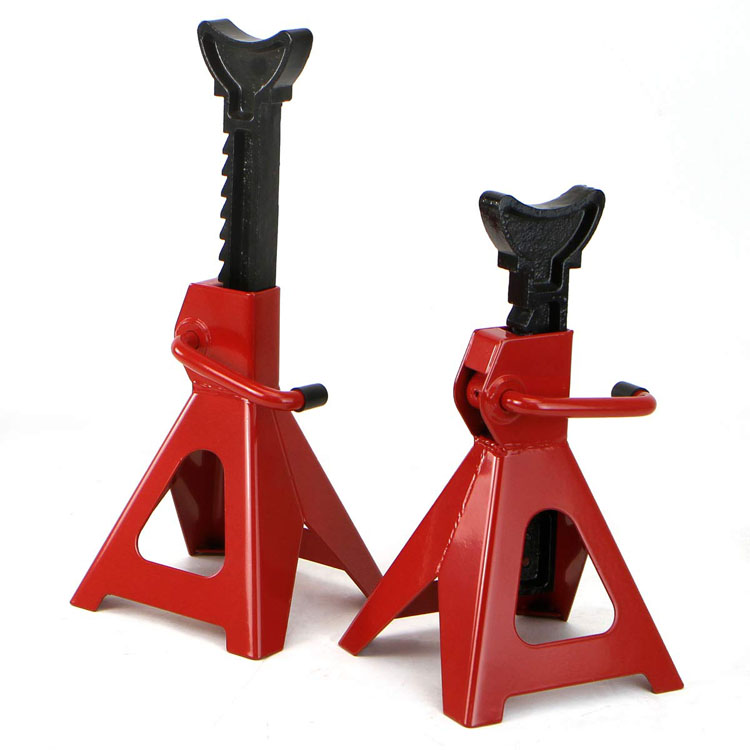Jack Stands shopping guide: How to choose the most suitable load-bearing model?
Jack stands (also known as safety brackets or repair brackets) are crucial tools for ensuring safety during car maintenance, upkeep, or tire replacement. However, if the wrong load-bearing model is selected, it may lead to deformation, fracture, and even serious accidents of the bracket. So, how to choose the right load-bearing model for Jack Stands? This article will combine safety standards, load-bearing calculations, and purchasing tips to help you make the best choice.

Why is the load-bearing model so important?
The main function of jack stands is to provide stable support after the vehicle is lifted, preventing the jack from accidentally failing and causing the vehicle to fall. If the load-bearing capacity of the bracket is insufficient, it may occur that the main function of the bracket is to provide stable support after the vehicle is lifted, preventing the jack from accidentally failing and causing the vehicle to fall. If the load-bearing capacity of the bracket is insufficient, it may result in:
- The bracket is bent or broken, causing the vehicle to fall off
- The locking mechanism fails and the vehicle suddenly descends
- Unstable support, vehicle shaking during maintenance
Jack Stands Load bearing Model Selection Guide
1. Determine the weight of your vehicle
Firstly, you need to know the curb weight (empty weight) of the vehicle, which can usually be found in the following locations:
- Vehicle User Manual ("Technical Parameters" or "Specifications" section)
- Door frame nameplate (near B-pillar, indicating GVWR or curb weight)
- Registration information of the Vehicle Administration Office
Common vehicle weight reference:
- Small sedans (such as Honda Fit): 1.0~1.2 tons
- Medium sized sedan (such as Toyota Camry): 1.4-1.6 tons
- SUV/pickup truck (such as Haval H6/Ford F-150): 1.8-2.5 tons
- Large off-road vehicles/commercial vehicles (such as Land Cruiser): 2.5-3.5 tons
2. Calculate the single point load-bearing requirement
Jack stands are usually used in pairs (supporting the front or rear axle), so the load-bearing capacity of a single bracket needs to meet the weight of one side of the vehicle plus safety redundancy.
Calculation formula:
- Single point load-bearing ≈ (curb weight of vehicle ÷ 4) × safety factor (1.25~1.5)
- For example, a 1.6-ton vehicle with a single point load capacity of (1600kg ÷ 4) × 1.5=600kg
- Therefore, choosing a bracket with a single load-bearing capacity of ≥ 0.75 tons (750kg) is safer
Special circumstances adjustment:
- Heavy front axle (engine in front): Calculated by (curb weight x 60%) ÷ 2
- Heavy rear axle (cargo/trailer): Calculated by (curb weight x 70%) ÷ 2
3.Choose a load-bearing model that meets the standards
The typical load-bearing models of jack stands on the market are:
- 1.5 tons (1500kg) → suitable for small cars
- 2 tons (2000kg) → suitable for mid size sedans/SUVs
- 3 tons (3000kg) → suitable for large SUVs/pickups
- 4 tons (4000kg)+→ suitable for heavy vehicles
Purchase suggestion:
- Better high than low! For example, for a 1.6-ton vehicle, it is recommended to choose a 2-ton bracket instead of a 1.5-ton one
- Buy in pairs to ensure that both brackets have the same load-bearing capacity
- Check certification (such as CE, ANSI, GB, etc.)
4. Pay attention to the material and safety design of the bracket
- Steel type: High strength alloy steel (Cr-V steel) is preferred, which is more durable than ordinary steel
- Locking mechanism: must have dual safety (ratchet+pin) to prevent accidental slippage
- Base stability: Wide anti slip base to avoid tipping over
- Adjustment range: The lowest height should be able to fit under the car, and the highest height should meet maintenance needs
Safety usage reminder
- Never rely solely on a jack to support a vehicle! After lifting, a bracket must be used
- Only place brackets at designated support points on the vehicle (refer to user manual)
- Ensure that the ground is flat and hard, and use shims if necessary
- Regularly inspect the bracket and replace it immediately if any deformation or rust is found

